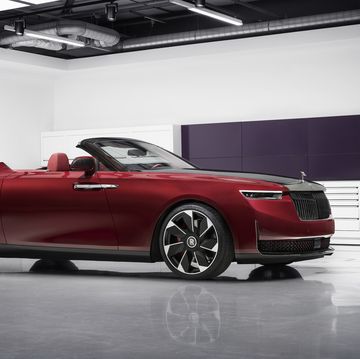At a glance, the new, second-generation Mercedes-AMG GT may not look all that different than its predecessor, but this is a very different car. Mercedes took the wraps off the new GT coupe in Monterey Friday, revealing a sports-GT that, as expected, now comes standard with all-wheel drive and available 2+2 seating.
Where the original AMG GT was based on a shortened SLS AMG platform, this car now shares its aluminum underpinnings with the new SL roadster. That means the new car ditches its predecessor's unique rear dual-clutch transaxle in favor of a conventionally mounted nine-speed multi-clutch gearbox. It also seems like the dry sump oiling system that allowed the original AMG GT's engine to be mounted relatively low in the chassis is gone, too, which in combination with the new gearbox enabled the use of all-wheel drive. The previous GT was a rear-drive-only affair. The 2024 model is also larger in every dimension than its predecessor.
The engine is the same basic 4.0-liter twin-turbo V-8 AMG has used for a number of years now. In the base GT 55, you get 469 hp and 516 lb-ft of torque while in the GT 63, the car pictured here, you get 577 hp and 590 lb-ft of torque, which matches the old AMG GT R. The new numerical nomenclature also brings the GT in line with the SL and ditches the confusing all-letters naming scheme of the old model.
Mercedes says the GT 63 runs from 0-60 mph in 3.1 seconds and on to a 196-mph top speed, while the GT 55 hits 60 in 3.8 seconds and tops out at 183 mph. The all-wheel-drive system is fully variable, able to send as much as 50 percent of torque to the front axle or 100 percent of torque to the rear. So hopefully the GT hasn't lost its appetite for tail-out whimsy.
There's a ton of interesting chassis hardware too. Like the SL, the GT uses all-aluminum multi-link suspension all around, and as standard, it comes with a hydraulic anti-roll control system similar to what's used by McLaren. There are no standard anti-roll bars—instead, the compression circuit of the damper on one side of the car is linked hydraulically with the rebound side of the damper across the axle, and vice versa. In essence, this allows for fully variable adjustment of roll-stiffness. This makes the car alternately more comfortable in everyday driving and reduces body roll on fast roads and on track. Also standard is rear-wheel steering and an electronically controlled rear limited-slip differential. The GT uses 20-inch wheels all around with a nearly square stance for its tires—295/35R20 up front, 305/35R20 in the back. That's a fair bit wider than what's used on the SL.
While the exterior of the new GT is distinct from the new SL, the interiors of the two cars are basically identical. That means you get a digital gauge cluster and a huge portrait-oriented center touchscreen running Mercedes' MBUX infotainment system. It's a lot more in line with other modern Mercedes cabins, giving the GT more of an, uh, GT-car vibe. The growth in size allows for the addition of two rear seats that can fold away to make a parcel shelf, just like a 911's. The GT also remains a hatchback, making this a relatively practical sports car.
We don't have pricing information just yet, but it seems fair to expect the GT 55 will cost around the same as the $141,300 as the SL 55, if not less, and same goes for the GT 63 vis a vis the $183,000 SL 63. Mercedes says deliveries will start some time in the first half of next year. Don't expect a GT roadster either—they call that the SL.
A car enthusiast since childhood, Chris Perkins is Road & Track's engineering nerd and Porsche apologist. He joined the staff in 2016 and no one has figured out a way to fire him since. He street-parks a Porsche Boxster in Brooklyn, New York, much to the horror of everyone who sees the car, not least the author himself. He also insists he's not a convertible person, despite owning three.














